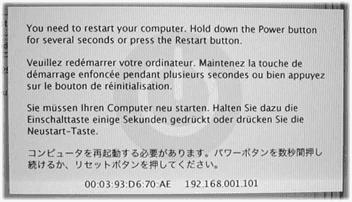Startup Problems
Not every problem you encounter is related to running applications. Sometimes trouble strikes before you even get that far. The following are examples.
Kernel Panic
When you see the cheerful, multilingual dialog box shown in Figure B-2, you’ve got yourself a kernel panic—a Unix nervous breakdown.

Figure B-2. A kernel panic is almost always related to some piece of add-on hardware. And look at the bright side: At least you get this handsome dialog box in Mac OS X 10.2. That’s a lot better than the Mac OS X 10.0 and 10.1 effect—random text gibberish super-imposing itself on your screen.
(In such situations, user panic might be the more applicable term, but that’s programmers for you.)
Kernel panics were rare to begin with, but in Mac OS X 10.2 and later they’re increasingly unusual. If you see one at all, it’s almost always the result of a hardware glitch: some memory board, accelerator card, graphics card, SCSI gear, or USB hub that Mac OS X doesn’t like.
If simply restarting the machine doesn’t help, detach every shred of gear that didn’t come from Apple. Restore these components to the Mac one at a time until you find out which one was causing Mac OS X’s bad hair day. If you’re able to pinpoint the culprit, seek its manufacturer (or its Web site) on a quest for updated drivers, or at least try to find out for sure whether the add-on is compatible with Mac OS X.
Note
This ...
Get Mac OS X: The Missing Manual, Second Edition now with the O’Reilly learning platform.
O’Reilly members experience books, live events, courses curated by job role, and more from O’Reilly and nearly 200 top publishers.

